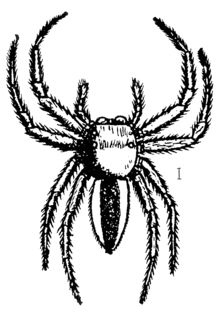Phintella lunda is a species of jumping spider in the genus Phintella that lives in Angola. It was first described in 2010 by Wanda Wesołowska, and given a specific name to reflect the fact that it was first found in Lunda Sul Province. The spider is medium-sized and a similar shape to others in the genus. It has a very dark brown carapace that has edge markings and a greyish-brown abdomen that has streaks on the top and sides, but the main distinguishing feature are the copulatory organs. The male has a distinctive straight side to its palpal bulb, while the female has am epigyne which has two pockets and copulatory openings in cups.
| Phintella lunda | |
|---|---|

| |
| The related male Phintella versicolor | |
| Scientific classification | |
| Domain: | Eukaryota |
| Kingdom: | Animalia |
| Phylum: | Arthropoda |
| Subphylum: | Chelicerata |
| Class: | Arachnida |
| Order: | Araneae |
| Infraorder: | Araneomorphae |
| Family: | Salticidae |
| Subfamily: | Salticinae |
| Genus: | Phintella |
| Species: | P. lunda
|
| Binomial name | |
| Phintella lunda Wesołowska, 2010
| |
Taxonomy
editPhintella lunda is a species of jumping spider, a member of the family Salticidae, that was first identified in 2010 by Wanda Wesołowska, one of over 500 species described by the Polish arachnologist during her career.[1][2] The spider's specific name is derived from the name of the area where it was first found.[3] The genus Phintella was raised in 1906 by Embrik Strand and W. Bösenberg. The genus name derives from the genus Phintia, which it resembles.[4] The genus Phintia was itself renamed Phintodes, which was subsequently absorbed into Tylogonus.[5] There are similarities between spiders within genus Phintella and those in Chira, Chrysilla, Euophrys, Icius, Jotus and Telamonia.[6] Genetic analysis confirms that it is related to the genera Helvetia and Menemerus and is classified in the tribe Chrysillini.[7][8]
Description
editThe spider was initially described based on a holotype specimen found in a collection at the California Academy of Sciences in San Francisco.[9] The spider is medium-sized and thin, with a shape that is typical of the genus. The dark brown carapace is oval, elongated, covered in short hairs and has a black and white line that lines its edges. The clypeus is very dark, while the oval abdomen is greyish brown with streaks along the middle and sides. The spinnerets are short and brown.[10]
The female and male are similar in size, with an abdomen that ranges in length between 2.0 and 2.7 mm (0.079 and 0.106 in) and a cephalothorax that varies between 1.7 and 1.9 mm (0.067 and 0.075 in) in length.[3] The male has a short embolus and triangular palpal bulb with a straight edge, a feature that is unusual in the genus.[11] The female has two copulatory openings in distinctive cups at the very end of the epigyne, which has two wide pockets either side of a central depression.[10]
Distribution
editPhintella lunda has only been found in the Lunda Sul Province in Angola. It is one of only a small number of species in the genus that have been found in Africa.[9][12]
References
editCitations
edit- ^ World Spider Catalog (2017). "Phintella lunda Wesolowska, 2010". World Spider Catalog. 18.0. Bern: Natural History Museum. Retrieved 23 April 2017.
- ^ Wiśniewski 2020, p. 6.
- ^ a b Wesołowska 2010, p. 112.
- ^ Bösenberg & Strand 1906, p. 333.
- ^ Cameron & Wijesinghe 1993, p. 16.
- ^ Prószyński 1983, p. 43.
- ^ Maddison & Hedin 2003, p. 541.
- ^ Maddison 2015, p. 231.
- ^ a b Wesołowska 2010, p. 111.
- ^ a b Wesołowska 2010, p. 114.
- ^ Wesołowska 2010, pp. 111, 113.
- ^ Dawidowicz & Wesołowska 2016, p. 452.
Bibliography
edit- Bösenberg, W.; Strand, Embrik (1906). "Japanische Spinnen" [Japanese Spiders]. Abhandlungen der Senckenbergischen Naturforschenden Gesellschaft. 30: 93–422.
- Cameron, H. D.; Wijesinghe, D. P. (1993). "Simon's Keys to the Salticid Groups". Peckhamia. 3 (1): 1–26.
- Dawidowicz, Angelika; Wesołowska, Wanda (2016). "Jumping Spiders (Araneae: Salticidae) of Kenya Collected by Åke Holm". Annales Zoologici. 66 (3): 437–466. doi:10.3161/00034541ANZ2016.66.3.010. S2CID 89556915.
- Maddison, Wayne P.; Hedin, Marshal C. (2003). "Jumping spider phylogeny (Araneae: Salticidae)". Invertebrate Systematics. 17 (4): 529–549.
- Maddison, Wayne P. (2015). "A phylogenetic classification of jumping spiders (Araneae: Salticidae)". The Journal of Arachnology. 43 (3): 231–292. doi:10.1636/arac-43-03-231-292. S2CID 85680279.
- Prószyński, Jerzy (1983). "Position of genus Phintella (Araneae: Salticidae)". Acta Arachnologica. 31 (2): 43–48.
- Wesołowska, W. (2010). "A new species of Phintella from Angola (Araneae: Salticidae)". Genus. 21: 111–114.
- Wiśniewski, Konrad (2020). "Over 40 years with jumping spiders: on the 70th birthday of Wanda Wesołowska". Zootaxa. 4899 (1): 5–14. doi:10.11646/zootaxa.4899.1.3.